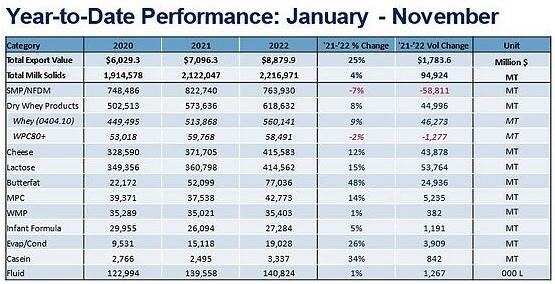While we’ve all turned our calendars to 2023, the publication of U.S. trade data slightly lags current conditions. Even still, the just published November 2022 data showed U.S. dairy exports will certainly set another record in 2022 and are prepared to keep on growing into 2023.
In milk solids equivalent (MSE) volume, U.S. dairy exports expanded by 9% (+16,011 MT) in November, putting year-to-date (YTD) exports up 4% (+94,924 MT MSE) for a total of 2.2 million MT MSE. In value terms, the U.S. had already set the annual record in October, but a 23% growth in November (+$148 million) is still worth celebrating.
Overall, the reliable growth of cheese (+13%, +4,282 MT) and whey products (+17%, +8,018 MT) kept U.S. volumes on their positive trajectory in November. Both products will be discussed in more depth below. Butter (+160%, +5,192 MT) and lactose (+9%, +3,189 MT) also shone. Of the major product categories, only NFDM/SMP (-3%, -2,185 MT) and fluid milk/cream (-25%, -3,383 MT) fell.

Visit USDEC’s Data Hub
Looking ahead, with shipping conditions considerably improved compared to this point last year, milk production expanding and international demand in key markets holding steady or growing, we expect U.S. dairy exports to continue 2022’s success into 2023 though there will certainly be plenty of challenges ahead. For this month’s report, let’s highlight the positive with two success stories: cheese and whey.
U.S. cheese exports set another monthly record in November
U.S. cheese exports extended their year-over-year (YOY) growth streak to 17 straight months in November. The United States shipped 37,495 MT of cheese to overseas markets, a 13% increase over the previous year and easily a November record. In fact, every month since February 2022 has been a new volume record for cheese exports for the respective month.
Major U.S. cheddar and gouda buyers led November gains, with overall cheese shipments to Japan rising 56% (+1,424 MT), Australia growing 56% (+1,432 MT) and Mexico gaining 15% (+1,370 MT).
Cheddar, gouda and other natural cheese under HS 0406.90 have fueled U.S. cheese export volume all year, and the story in November was no different. Year-to-date through November, U.S. cheddar exports were up 60% (+29,785 MT) while all other natural cheese exports under 0406.90 grew 21% (+18,151 MT).
November also benefitted from the continued rebound in U.S. grated cheese exports, which is predominantly mozzarella/pizza cheese. U.S. grated cheese exports were down 9% over the first seven months of the year, but from August-November, they rose 12%, with November showing the biggest increase. U.S. shipments of grated cheese rose 27% (+1,954 MT) for the month, supported by strong sales to Central America and the Middle East.
Total U.S. cheese sales to Central America rose 12% YOY in November (+370 MT), with grated cheese sales to the region more than doubling (+868 MT). Similarly, overall U.S. cheese sales to the Middle East jumped 80% (+1,175 MT) in November, with grated cheese sales to the region more than tripling (+732 MT).
Looking ahead, we are still cautiously optimistic about the coming year. We continue to see growth ahead, but a rebound in EU milk production, economic factors that support cheese analogue use in Latin America and potentially tighter U.S. exportable cheese supplies will likely lower the double-digit growth rate we’ve seen for much of 2022.
Whey exports to China soar
U.S. whey exports increased 17% (+8,018 MT) in November, as a huge increase to China (+71%, +11,948 MT) helped offset declines in other regions. Year-to-date, U.S. whey exports were up 8% (+44,996 MT), with much of the growth, especially in the first part of the year, coming from low-protein whey.
However, more recently, we have seen a sharp jump in high-protein whey exports as U.S. inventories ballooned amid weaker domestic purchases pushing U.S. manufacturers to look increasingly toward export markets. Corresponding with weaker domestic demand, prices have also eased. U.S. WPC80 and WPI prices have fallen roughly 40% since May which, when paired with weaker domestic purchases, has allowed greater export opportunity as many international importers balked at the high prices earlier in the year or purchased reduced volumes.
On the commodity side, Chinese whey imports have been on a rebound since late summer and have been driven by higher pork prices which incentivize greater whey use in hog feed to accelerate production and growth. We’ve talked about this demand factor in previous reports, but a more recent development has been the strong price correction in Chinese pork prices since late November.
Pork prices topped out just shy of ¥42/kg in November but have since come down to ¥33/kg. While still higher than the roughly ¥25/kg average price seen throughout 2021 and in the years prior to African Swine Fever-induced price volatility, that ¥33/kg price will likely start to soften demand moving forward, especially as pork supply preparations in advance of Chinese New Year have all but concluded. We may see continued growth in Chinese whey demand into 2023, but as we transition into Q2 of next year, expect lower pork prices to cap volume growth compared to what we have seen over the last several months.
Click here to see more...